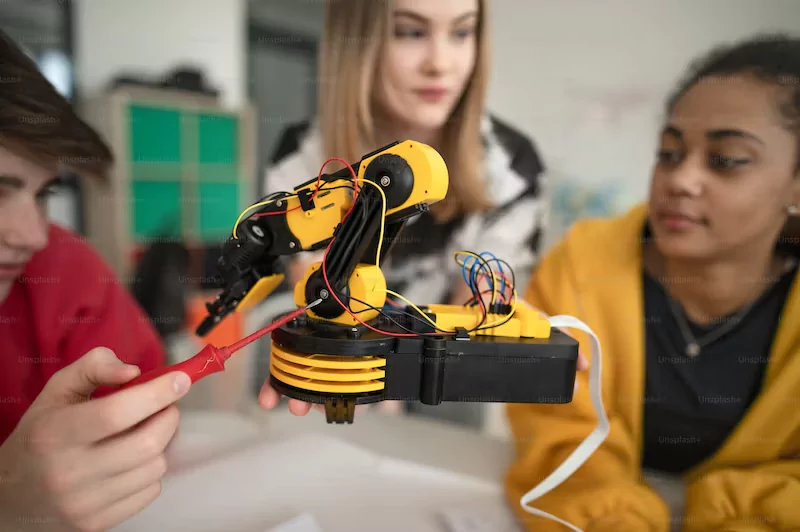Update: This article was last updated on 8th October 2024 to reflect the accuracy and up-to-date information on the page.


Have you noticed how the world is changing rapidly, with technology advancing at an unprecedented rate? The demand for skills like coding and robotics for kids, as well as AI and machine learning, is increasing daily, and it’s never too early to start preparing your kids for the future. Not only will they have a better understanding of the world around them, but they will also be better equipped to tackle some of the biggest challenges we face as a society.
“Coding and robotics, along with AI, are not just buzzwords – they’re the future.” These skills can equip your child with the tools they need to succeed in a world where technology is constantly evolving. Moreover, learning about coding and robotics and machines can be a fun and exciting way for children to engage with education. Coding and robotics encourage creativity, innovation, and curiosity, essential skills for success in today’s time and age. So why not get your kids involved in learning about coding and robotics early on and help them build a brighter future for themselves?
Growing Demand for Tech Skills
According to the U.S. Bureau of Labor Statistics, jobs in computer and information technology are projected to grow by 15% from 2021 to 2031, much faster than the average for all occupations. This growth highlights the increasing demand for coding, robotics, and AI skills in various industries.
Early Coding Education Impact
Research by MIT shows that children who start learning to code at an early age demonstrate improved cognitive development, logical thinking, and problem-solving abilities. Studies also reveal that coding education improves performance in subjects like math and science, enhancing overall academic success.
AI Job Market Forecast
A report from PwC predicts that AI could contribute up to $15.7 trillion to the global economy by 2030. This shift is expected to impact nearly every industry, meaning that children who learn AI and coding early will be better prepared to adapt to future job markets.
Success Rates of Early Tech Education
A study by Code.org shows that students who learn coding in middle and high school are more likely to pursue careers in computer science and STEM fields. Additionally, these students have a higher rate of college enrollment in STEM majors compared to those without coding experience.
Worldwide Tech Education Trends
Globally, countries like Estonia and Finland have already integrated coding into their national curriculums for elementary schools. In the U.S., 40% of schools offer coding programs, and the number continues to grow each year.
When should kids begin learning to code?
As schools start teaching cool things like AI, coding and robotics, parents and teachers often wonder when kids should start learning to code. Learning to code early is like building a strong base for advanced stuff like AI and machine learning. A survey shows that more than half of pro coders wrote their first code around age 14. But, guess what? Kids can start as young as four! As they get older, like in middle school, they can use special coding and robotics platforms to practice. And hey, robotics programming for kids can be super fun too! Teachers can spot kids who love coding and robotics and start teaching them early. This helps them work together, be creative, and get ready for cool jobs in the future. So, coding and robotics? Start early and have a blast!
5 Reasons Why Your Child Needs to Learn Coding, Robotics, and AI
| No | Skill | Description |
|---|---|---|
| 1 | Enhance problem-solving skills | Engaging with robotics develops problem-solving skills; kids learn to analyze, plan, experiment, and adjust their approach when faced with challenges. |
| 2 | Enhance Creative Expression | Coding, robotics, and AI offer endless opportunities for innovation; kids can use these skills to create new and unique projects, fostering creativity and originality. |
| 3 | Foster teamwork and collaboration | Robotics and coding involve teamwork; programs like FIRST Robotics Competition provide opportunities for communication, collaboration, and leadership development. |
| 4 | Entrepreneurial Mindset | Learning AI and coding cultivates resilience and adaptability; kids can identify problems, create solutions, and develop an entrepreneurial mindset for future success. |
| 5 | Future-proof their career | With AI advancements, learning coding and robotics early prepares kids for future job markets; it cultivates creativity, critical thinking, and problem-solving skills, making them valuable assets. |
| 6 | Future-Readiness | Understanding how coding skills are used in robotics, AI, and other technological fields prepares children for the future job market. |
1. Enhance problem-solving skills
Activities that involve programming robots provide an excellent opportunity for kids to enhance their problem-solving skills. By engaging with these technologies, children can develop the skills and mindset necessary to tackle complex problems in various contexts.
How? Let’s understand using an example:
For instance, a child may be given instructions and asked to program a robot to navigate through a maze. To do this, the child must first analyze the maze and identify potential obstacles. They must then develop a plan for guiding the robot through the maze using the programming tools.
Through this activity, the child learns to use their analytical and critical thinking skills to break a complex problem down into smaller, more manageable parts. They also learn problem-solving skills in several ways.
Similar to this activity, you’ll see that most robotics kits for kids and programs are designed to help children hone their ability to experiment and adjust their approach as they encounter obstacles or setbacks.
2. Enhance Creative Expression
Coding, robotics, and AI offer endless opportunities for innovation. Your child can use these skills to create something new and useful. One example of a robotic kit or program that supports creative development is the LEGO Mindstorms robotics kit. This kit provides children with the tools they need to build and program their robots using a combination of LEGO bricks, sensors, motors, and a programmable computer brick. With the Mindstorms kit, children can experiment with different designs and programming techniques to create their unique robots. For example, they might build an AI coding robot that can follow a line or create a robot that can solve a Rubik’s cube. In the process, children are encouraged to think creatively and develop their solutions to complete the task.
3. Foster teamwork and collaboration
Robotics, AI, or Coding as a field of study requires children to work in teams to design, build, and program complex systems. Each program provides children valuable opportunities to practice communication, collaboration, and leadership.
One example of a program that specializes in team collaboration is the FIRST Robotics Competition. This program challenges teams of high school students to design, build, and program robots to compete in a series of challenges.
Along the way, students must work together to solve complex problems and develop strategies for success. VEX Robotics Competition is another program you can explore with your kids.
At the school level, there are also a variety of tools and resources available to help children learn more about AI. For example, Scratch and TensorFlow. These provide students with tools and resources that allow users to build and train their machine-learning models using a variety of programming languages.
Learning through these tools gives children access to global communities, allowing them to connect with other students who share their interests and passions.
4. Entrepreneurial Mindset
Entrepreneurship requires resilience, persistence, and adaptability – essential for success in any field. By introducing your child to the exciting world of AI, you’re allowing them to develop an entrepreneurial mindset and thrive in the ever-evolving job market.
“Imagine your child having the ability to identify a problem and create a solution to solve it.”
AI is a field ripe for exploration and innovation, and by learning how to code and program AI, your child can analyze data and make predictions to discover new areas to explore. This can help them create their own tech startup or freelance projects.
5. Future-proof their career
With almost half of U.S. jobs predicted to be replaced by AI by 2033, preparing children for the technological advancements that lie ahead is crucial. By learning these skills at a young age, they’ll have a head start and be able to position themselves as valuable assets in various industries.
But it’s not just about securing a job. Learning these skills cultivates creativity, critical thinking, and problem-solving skills, which are valuable in all domains. By nurturing these skills, children can be empowered to create their own opportunities and shape the future uniquely.
In addition to fostering their coding, robotics, and AI skills, encouraging your child to participate in coding competitions can further enhance their abilities and boost their passion for technology and innovation. Coding competitions provide a platform for students to showcase their coding prowess, problem-solving capabilities, and creativity in a competitive setting.
So don’t hesitate to give your child the gift of a brighter future by enrolling them into online coding classes for kids. Start exploring the world of coding, robotics, and AI today and watch as they flourish and grow into the innovators of tomorrow.
Want to make your child future-ready with Robotics? Moonpreneur offers a tailor-made program. Reserve a spot in our free 60-minute workshop today and introduce them to the amazing world of robotics and innovations!

























